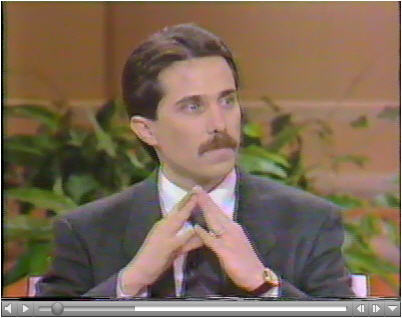View current page
...more recent posts


Gore Vidal on Film; Javier Morales and John Michael Boling's "The Church of the Future"
From an interview with Gore Vidal in this month's Bookforum:
BF: Your writing career extends to the silver screen, particularly your script for Ben-Hur. You wove in a homoerotic story line that suggested a past romance between Ben-Hur and Messala, but this fact was supposed to be kept secret from Charlton Heston. Was there a thrill in doing that?What Vidal says about film--it's the only art form that "lacks mind"--and the default role of editors in creating that art is a slap at auteur theory but I agree with him in the sense that film is more like painting or music than literature. I thought about his comment when I saw this web video by Javier Morales and John Michael Boling called "The Church of the Future," which assembles a story out of pure televisual vapor. It has no more or less "mind," in the sense of a cognizable rhetorical point, than the Nightly News does--another kind of "film," which we take to be real, but which is a crafted amalgam of clips that may convey messages different than what the producers intended. Yet the "Church" video is profound, in the way its editing choices create a mood of tension and weirdness out of sampled mainstream TV (only the Marilyn Monroe mask wearing businessman--which seems very DEVO/Subgenius/Firesign Theatre--departs from "ordinary."). Some of the big hair reaction shots from a random "televangelical" audience are exquisite portrait photographs.
GV: No, it was necessity. The script just didn't work. I had to explain why on earth they're feuding for four hours. The romantic subtext worked like a dream.
BF: Charlton Heston, of whom you wrote directing him must be like trying "to animate an entire lumberyard," refused to acknowledge your contributions to the script, insisting that the director, William Wyler, rejected your suggestions.
GV: Charlton Heston told lies. I had as little to do with him as possible. He was also the last choice of the director and the producer. They were stuck with him. And then it turned out he wasn't as good as Stephen Boyd, who played the Roman. But that was not my problem. I was not producing it. I was there to try to dramatize an old and rather junky story.
BF: In the new memoir, you say that, in today's culture, "where literature was movies are." Are there films that rank with good literary fiction?
GV: I don't think you could ever compare the two. Literature is where it is and totally different, and movies are a peculiar art form. Film is the only art form that lacks mind, because there's no way the individual writer can supply it with ideas. Directors make their contributions, some better than others. Film editors probably do the most work toward creating what you see up on the screen. And they are working quite separately from whatever the movie may be about. They're just trying to get images straight. It's not a medium you can invest with the sort of ideas that work in a novel or even poetry.
Update: scare quotes added to the word televangelical since we have no idea who this audience is. See comments.
